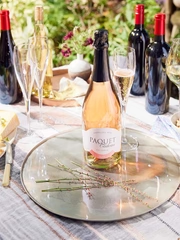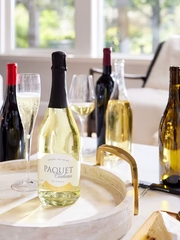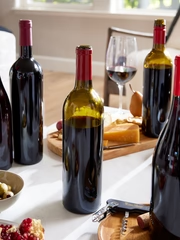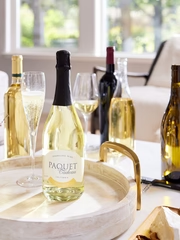 Many cellars still have the ability to work traditionally, by using oak in different ways such as wood provenance, toast or barrel sizes to influence the flavor of the final wine. Others have opted for an even more old world and traditional approach by resurrecting the oak tank, also called oak upright.
Increased demand for wine has opened the doors for the cooperage industry to offer many types of products that mimic, or in some cases, equal the benefits of barrels. These products are called oak alternatives.
Many cellars still have the ability to work traditionally, by using oak in different ways such as wood provenance, toast or barrel sizes to influence the flavor of the final wine. Others have opted for an even more old world and traditional approach by resurrecting the oak tank, also called oak upright.
Increased demand for wine has opened the doors for the cooperage industry to offer many types of products that mimic, or in some cases, equal the benefits of barrels. These products are called oak alternatives.
 The picture above represents the byproduct of processing an oak tree for the production of barrel staves. Indeed, after sawing, splitting and cutting, we end up with many scraps. It is important to note that no more than 40% of a mature oak tree will end up as a wine barrel. The wood selected for barrel production must be perfect, without any cracks or knots. The large majority of what is left will end up as furniture.
Oak Chips in Winemaking
Oak chips are the most common of all oak alternatives, and are added at various stages of the winemaking process, straight into the ferment or dipped into the wine tank. Due to the greater surface area they cover, smaller chips give more character per unit weight added. They usually release all of their characters within a week or so of immersion in the wine.
Oak Powder in Winemaking
Oak powder provides a marvelous result in reducing a wine's herbaceousness. This adjunct is convenient, easy to use and has a high surface-area-to-mass ratio. During fermentation, the yeast transforms the more intense oak compounds into less aromatic ones, making the oak smoother and less aggressive. The result is a better mouthfeel: more weight and length in the finish.
Oak Staves in Winemaking
You may have started to guess now that the larger the exposure area is, the larger the impact will be. Wines can also gain oak character by inserting oak planks or staves directly into the tank. This process works at a slower pace to extract woody characters like a barrel would. The toast depth reaches a little less than 3⁄8ths of an inch. This configuration gives a more natural “barrel-like” experience. This process can take up to 18 months depending on the toast.
The picture above represents the byproduct of processing an oak tree for the production of barrel staves. Indeed, after sawing, splitting and cutting, we end up with many scraps. It is important to note that no more than 40% of a mature oak tree will end up as a wine barrel. The wood selected for barrel production must be perfect, without any cracks or knots. The large majority of what is left will end up as furniture.
Oak Chips in Winemaking
Oak chips are the most common of all oak alternatives, and are added at various stages of the winemaking process, straight into the ferment or dipped into the wine tank. Due to the greater surface area they cover, smaller chips give more character per unit weight added. They usually release all of their characters within a week or so of immersion in the wine.
Oak Powder in Winemaking
Oak powder provides a marvelous result in reducing a wine's herbaceousness. This adjunct is convenient, easy to use and has a high surface-area-to-mass ratio. During fermentation, the yeast transforms the more intense oak compounds into less aromatic ones, making the oak smoother and less aggressive. The result is a better mouthfeel: more weight and length in the finish.
Oak Staves in Winemaking
You may have started to guess now that the larger the exposure area is, the larger the impact will be. Wines can also gain oak character by inserting oak planks or staves directly into the tank. This process works at a slower pace to extract woody characters like a barrel would. The toast depth reaches a little less than 3⁄8ths of an inch. This configuration gives a more natural “barrel-like” experience. This process can take up to 18 months depending on the toast.


 Australian wines in the 1980's flooded the market with heavily-marketed "bookcase-flavored" wines. The goal today is not to start a new brand called “Chateau Plywood,” but to maximize the true potential of the grapes in good or more difficult vintages. Wineries try to achieve an oak flavor profile that is appropriate to the wine description, without overwhelming it. This toasting is very rigorously controlled and can be fine-tuned to make oak products with high levels of vanilla, tannins, 5-methyl furfural (the sugary-creamy character that is very nice in Chardonnay) or even guaiacol (smoke). A specific toast level is chosen to complement each wine. Usually light toasts go into whites, dark toasts into heavy reds. Sometimes a blend of lighter and darker toasts is used, to give both sweet vanilla notes and a layer of smokiness.
Oak alternative usage came into practice in 1993 and unfortunately it still carries a little stigma today, associated with the earlier, poorer quality wines. Technology and scientific innovation are continuing to make better and more consistent quality wines. No matter what, wine drinkers choose to purchase based on price point, origins, mouthfeel, balance, aromas, variety and brand.
Australian wines in the 1980's flooded the market with heavily-marketed "bookcase-flavored" wines. The goal today is not to start a new brand called “Chateau Plywood,” but to maximize the true potential of the grapes in good or more difficult vintages. Wineries try to achieve an oak flavor profile that is appropriate to the wine description, without overwhelming it. This toasting is very rigorously controlled and can be fine-tuned to make oak products with high levels of vanilla, tannins, 5-methyl furfural (the sugary-creamy character that is very nice in Chardonnay) or even guaiacol (smoke). A specific toast level is chosen to complement each wine. Usually light toasts go into whites, dark toasts into heavy reds. Sometimes a blend of lighter and darker toasts is used, to give both sweet vanilla notes and a layer of smokiness.
Oak alternative usage came into practice in 1993 and unfortunately it still carries a little stigma today, associated with the earlier, poorer quality wines. Technology and scientific innovation are continuing to make better and more consistent quality wines. No matter what, wine drinkers choose to purchase based on price point, origins, mouthfeel, balance, aromas, variety and brand.





